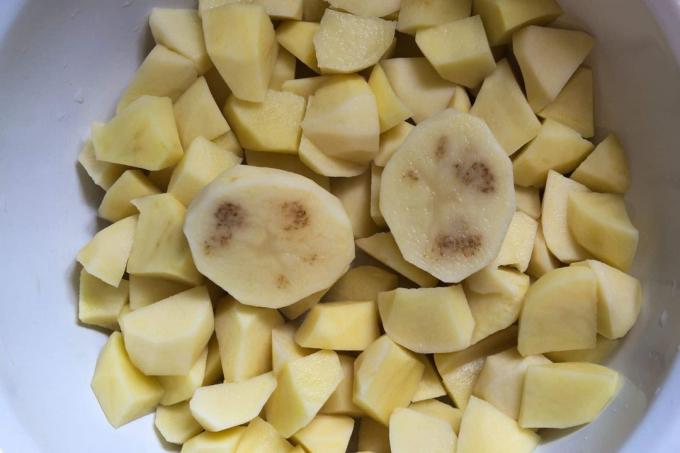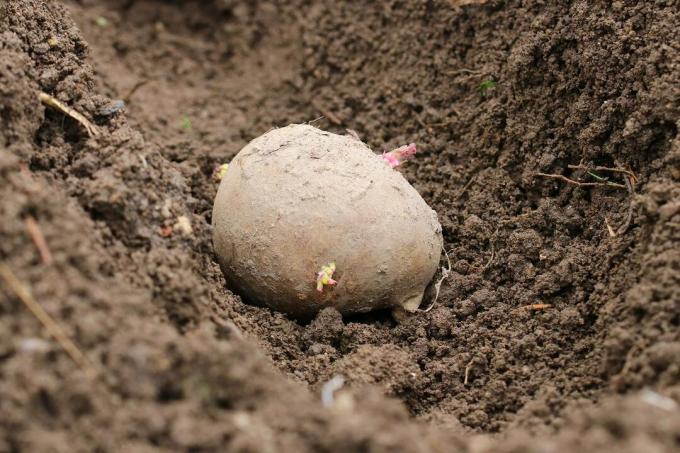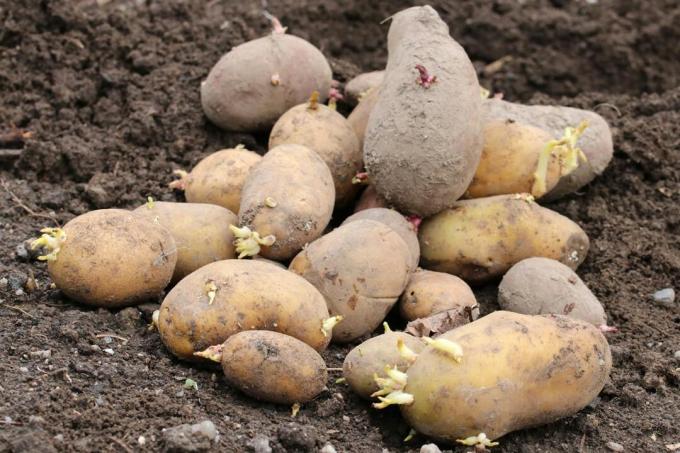

Table of contents
- laying depth
- row spacing
- new potatoes
- Storage potatoes (late varieties)
- particularities
- balcony planting
- potatoes in hay
- Potatoes without a dam
- Potatoes in the ditch
The correct distance between the laying potatoes is just as important for the yield as a well-prepared bed and a good supply of nutrients. This article provides information about the correct spacing and depth of planting of the potatoes.
laying depth
How deep potatoes are planted does not matter as much compared to the in-row and inter-row planting distance. With some cultivation methods, no plant furrow is made at all. In contrast, growing potatoes in ditches rather than ridges. Usual furrows are about 5 to 10 cm deep, which is quite sufficient for potatoes.
row spacing
Potatoes are piled up in the ridge culture. Appropriate space between the rows must be planned for this. This is about 50 cm for new potatoes. Better a little more than too little, so that decent dams can be made several times. These increase the harvest by forming new tubers on the shoots and prevent the potatoes from turning green. The dams are only leveled during the harvest, hardly any potatoes have to be dug up.
new potatoes
Since the cultivation time for early potato varieties is comparatively short, the distance between them is also different from that of potatoes for storage. New potatoes are usually pre-germinated before they are planted. The first germs and shoots are already forming and, with a bit of luck, roots.
A notice:
The yield of early potatoes should be increased if potatoes with many shoots are spaced farther apart than potatoes with fewer shoots.
A simple rule is that potatoes should be placed in the rows with a foot space between them. The average is 30 to 40 cm. However, putting your foot between the potatoes makes it easier to keep your distance.
Storage potatoes (late varieties)
Late varieties are not only planted and harvested later, they also have a much longer cultivation time, which means that they have to be earthed up more often. A row spacing of 75 cm makes sense for this work. The spacing in the row is the same as that of the new potatoes.
Other conditions on which the laying distance depends:
- potato variety
- laying time
- cultivation method
- size of the seed potatoes
- existing space
particularities
There are different ways to grow potatoes. We show what special features there are in each laying.

balcony planting
Potatoes can certainly be grown on the balcony, but the harvest is small due to the limited space. The remedy is different methods of planting potatoes on the balcony, aimed at over to repeatedly harvest smaller tubers from the plant over a longer period of time, but they continue to grow permit. For planting depth and spacing, this means that only one potato plant is counted on a balcony planter of the usual size. Distances are omitted. The depth mainly depends on the amount of substrate.
potatoes in hay
In addition to the usual planting in ridges, potatoes can also be grown in hay, grass clippings or even sheep's wool with far less effort. The laying depth does not apply to these variants, since the potatoes are laid on the bare soil, the distance corresponds to that of the ridge planting. After planting, the potatoes are covered as tightly as possible. The material used should release nutrients evenly over a longer period of time and be constantly renewed. It is important that the potatoes are always covered so that they do not get sun and turn green.
Potatoes without a dam
Planting potatoes in a dam has advantages, but it's not a must. If potatoes are not piled up, the harvest is usually smaller, but the row spacing does not have to be quite as large. Smaller row spacings ensure that the potato plants quickly shade the area sufficiently, making life difficult for weeds.
Potatoes in the ditch
Instead of piling up potatoes, they can also be placed in ditches that are slowly filled in during the cultivation period. The effect is the same as with the ridge culture, but has the advantage that the ridges cannot be leveled by heavy rain and therefore no potatoes are exposed. The disadvantage of trench culture lies in the more difficult harvest and the reduced warming. In addition, ditches and dams must have a suitable distance from one another in order to be able to be worked properly.
A notice:
The trenches are dug about a spade deep. Also deeper in compacted, heavy soils.
 Home editorial office
Home editorial office
Learn more about potatoes

Potato is brown inside: is it edible?
After peeling or cooking, a potato has brown to black spots on the inside. This doesn't look very appetizing at first. And above all, the question arises as to whether the potato is still suitable for consumption or not. Since the causes of this discoloration can vary, in some cases it is due to […]

Black spots on potatoes: still use them?
Potatoes can have black spots. The potatoes are almost always edible despite the black spots. However, affected potatoes may show changes in taste and texture.

Time: from and until when do you plant potatoes?
Potatoes are among the most widely grown vegetables. So that self-cultivation works and a lush harvest can be brought in over many months, self-cultivators should pay attention to one important point: the right time to plant.

Planting potatoes: distance and depth
The potato (Solanum tuberosum) is a staple food with a wide range of preparation options. The tubers are indispensable in many dishes and are tastiest when you pick them yourself. What could be more obvious than growing them yourself. You can do this without your own garden.

Mixed culture: 14 good neighbors of potatoes
German cuisine would be unthinkable without potatoes. Have you ever thought about growing the delicious tubers in your own garden? Use the advantages of a mixed culture! We present 14 plants that are suitable for mixed cultivation with potatoes.

Storing & Cellaring Potatoes | 10 tips for storing potatoes
The potato is one of the most traditional vegetables in this country and can hardly be surpassed in terms of culinary variety. Anyone who grows them in their own garden can benefit from a huge variety of varieties and, if stored appropriately, can benefit from them for a long time.


